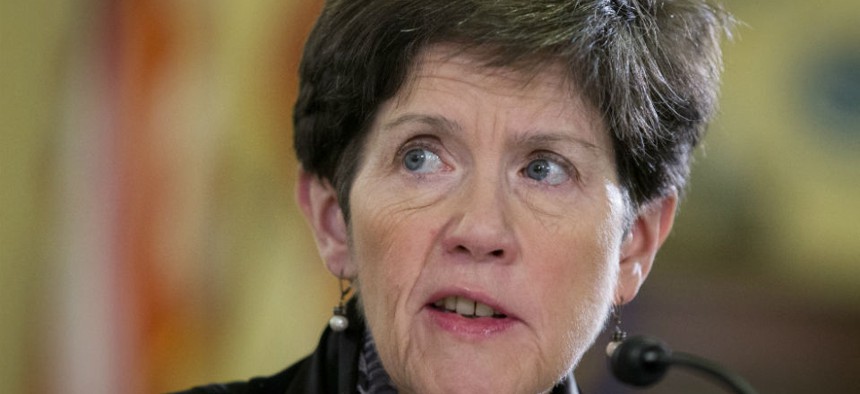
Veterans Affairs Interim Undersecretary for Health Carolyn Clancy testifies on Capitol Hill in February. Manuel Balce Ceneta/AP
Despite Upticks, VA Defends Improvements in Wait Times for Care
Officials dispute media reports claiming improvements are overstated.
The Veterans Affairs Department defended its improvement and newfound transparency in vets’ wait times for care, while taking issue with media reports challenging senior officials’ public testimony.
In a blog post Thursday, the Veterans Health Administration interim Undersecretary for Health Carolyn Clancy touted the agency’s initiative to publicly post wait time data in the wake of last summer’s revelations that department personnel had manipulated such data to cover up the long waits many veterans experienced before receiving care. She also noted VHA has improved the standards it uses to track the data to “more accurately reflect whether or not a veteran has been waiting too long for an appointment.”
“We report this completed appointment average wait time data monthly,” Clancy wrote. “VA also regularly advises and updates veterans service organizations and congressional stakeholders on our patient access data and wait time methods.”
Without mentioning it by name, Clancy condemned a CNN report that accused VA officials of lying during congressional testimony in February. Officials said at the hearing the average wait time at facilities in the Los Angeles area had been cut to four days, while CNN said the actual figure was 12 times that number.
“That assertion is incorrect,” Clancy said on Thursday. The discrepancy, according to VA, was just a misunderstanding.
VA puts out two sets of data on the amount of time veterans wait to receive care: appointments completed and appointments pending. The completed data -- which officials cited at the hearing -- are the more accurate of the two, Clancy said, as pending data do not include appointments completed immediately or within two weeks.
VA’s database of completed appointments -- released in late March and current through January -- does in fact show an average wait time of 4 days at Los Angeles area facilities. The pending data as of March confirms CNN’s report, but Clancy maintained that information is “not what VA considers to be the true measure of how long veterans are actually waiting.”
Still, even by VA’s preferred completed appointment metric, the percentage of veterans nationwide waiting more than 30 days for care has ticked up since August to 3.5 percent. The number of veterans across the country waiting more than 120 days jumped more than three times in January to more than 5,000 individuals.
VA recently came under fire for its new choice program, which allows vets waiting more than 30 days for an appointment, or those living more than 40 miles from a VA facility, to receive private health care at the government’s expense. Far fewer veterans have enrolled in the program than lawmakers anticipated, though a recent clarification of the law will double the number of eligible vets.
Clancy vowed to continue to make improvements to care and solicited feedback to better understand veterans’ desires.
“The measure that matters most is patient satisfaction,” Clancy wrote. “VA is committed to providing care when and where the veteran wants it.” She added: “We want to incorporate that knowledge into our strategic decision-making, and use it to improve the Veteran experience and access to care.”







